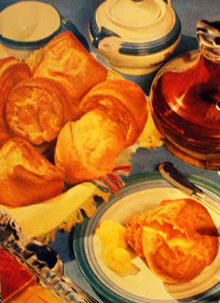- 1 cup milk
- 1 cup flour
- 1/2 tsp. salt
- 2 eggs, beaten
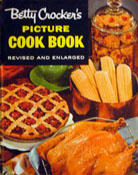 from Betty Crocker's Picture Cook Book (1956)
from Betty Crocker's Picture Cook Book (1956)
Beat together the flour, salt, milk and eggs with an electric beater. Pour into well-greased deep muffin cups so that the cups are three-quarters full. (For glass cups, 1/2 full.) Bake at 425° for 40 to 45 minutes.
Most popover recipes have the same basic ingredients -- milk, flour, eggs, salt -- with the optional ingredient of melted butter. Where they vary more is the oven temperature and cooking time, plus how full the cups should be with batter.
- 1 cup milk
- 1 TB. melted butter
- 1 cup flour
- 1/4 tsp. salt
- 2 eggs, beaten
 from Joy of Cooking (1975)
from Joy of Cooking (1975)
Bring ingredients to room temperature. Beat milk, butter, flour and salt until smooth. Add eggs one at a time, but do not overbeat. Fill buttered baking cups three-fourths full. Bake at 450° for 15 minutes, then lower heat to 350° and bake for 20 more minutes. To test for doneness, remove a popover to see if the side walls are firm. If not cooked long enough, the side walls will collapse.
Filling the cups too full with batter will cause a heaver, muffinlike texture, the book says. Also, the greased muffin cups/muffin pans/popover pans can be dusted with sugar, flour or grated Parmesan, which gives the batter something to cling to as it climbs the walls. (I know that when I'm climbing the walls, all I want is something to cling to ...)
- 1 cup milk
- 1 TB. melted butter
- 1 cup flour
- 1/4 tsp. salt
- 2 eggs, beaten
- 1/2 cup sharp Cheddar cheese or Parmesan, grated
- 1/8 tsp. paprika
- pinch of cayenne pepper
Bring ingredients to room temperature. Beat milk, butter, flour and salt until smooth. Add eggs one at a time, but do not overbeat. Mix cheese with paprika and cayenne. For each popover, spoon a tablespoon of batter into a greased muffin cup, then a few teaspoons of the cheese mixture, then another tablespoon of batter. Bake at 450° for 15 minutes, then lower heat to 350° and bake for 20 more minutes. To test for doneness, remove a popover to see if the side walls are firm. If not cooked long enough, the side walls will collapse.
Cookbook originally said "a few grains cayenne," but I have a hard time believing that a few grains would make any difference in the taste.
- 2 eggs
- 1 cup milk
- 1 cup flour
- 1/2 tsp. salt
- 1 TB. vegetable oil or melted shortening
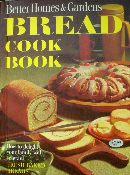 from Better Homes and Gardens Bread Cook Book (1963)
from Better Homes and Gardens Bread Cook Book (1963)
Break eggs into a bowl, then add milk, flour and salt. Beat 1 1/2 minutes with electric beater, then add vegetable oil and beat for 30 more seconds. Fill 6 to 8 well-greased custard cups 1/2 full. Bake at 475° for 15 minutes, then reduce heat to 350° and bake for 25 to 30 minutes more, or until browned. A few minutes before removing from oven, prick each with a fork to let steam escape. If you like them dry inside, turn off oven and leave for 30 minutes with door ajar.
Another classic popover recipe. Slightly more salt than the Joy of Cooking version.
- 1/3 cup fresh-cut corn kernels
- 1 cup milk
- 2 eggs
- 1 cup flour
- 3/4 tsp. salt
- 1 TB. vegetable oil
Break two eggs into a bowl, then add milk, flour and salt. Beat 1 1/2 minutes with electric beater. Add vegetable oil and beat for 30 more seconds. Stir in corn. Fill 6 to 8 well-greased custard cups 1/2 full. Bake at 475° for 15 minutes, then reduce heat to 350° and bake for 25 to 30 more minutes, or until browned and firm. A few minutes before removing from oven, prick the popovers to let steam escape. Turn off oven and leave for 15 minutes with door ajar.
Classic popover recipe, with corn, which I guess is the surprise. (Not much of one.)

I much prefer the style of pan #1, which is made specifically for popovers. The wells are deep, allowing the batter to climb the walls and then puff out the top, creating the classic popover shape. The removable cups, as in #2, seem unnecessary, as well as being a little too shallow, which is also the problem with combination popover and muffin pans, #3, and glass custard cups, #4.
- 3 eggs
- 1 can condensed cream of mushroom soup
- 1 cup flour
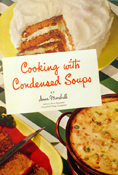 from Cooking With Condensed Soups (1953)
from Cooking With Condensed Soups (1953)
Beat eggs and soup together, then add flour and beat until smooth. Heat greased muffin or popover pans until sizzling hot, then fill three-quarters full with the thin batter. Bake at 450° for 30 minutes, then reduce heat to 350° and bake 10 minutes longer.
Popover recipes are usually pretty simple, but this one outdoes itself.
- 1 cup flour
- 1/4 tsp. salt
- 1 tsp. sugar (optional)
- 1 TB.melted butter
- 1 cup milk
- 2 eggs
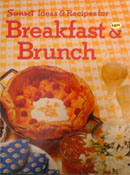 from Sunset Ideas & Recipes for Breakfast and Brunch (1980)
from Sunset Ideas & Recipes for Breakfast and Brunch (1980)
In a bowl, stir together flour, salt and sugar (if used) until blended. Add butter, milk and eggs, and beat about 2 1/2 minutes. Pour into greased muffin, custard or popover pans, filling each about one-half full. For a deep brown popover with a moist interior, bake at 400° for 40 minutes until browned and firm to touch. For a lighter popover, bake at 375° for 50-55 minutes. For a popover that is especially dry insde, loosen the popovers frm the pan but leave in the pan at an angle, prick with a skewer, and leave in the turned-off oven for 10 minutes.
From the cookbook: "These fragile shells are nothing but crisp golden crusts and air. You can bake them in your choice of containers: shiny, lightweight metal muffin pans; dark, heavy cast-iron popover pans; or ovenproof glass custard cups. But once they're in the oven, no peeking or they'll fall flat! Lavish these light hollow muffins with butter and preserves or fill them with a creamy entrée."
- 1/2 cup milk
- 2 TB. butter
- 1/4 tsp. salt
- dash of pepper
- 1/2 cup flour
- 2 eggs
- 1/2 cup Swiss cheese, shredded
In a pan, combine milk, salt, butter and pepper. Bring to a boil over medium heat. Add flour all at once and stir until mixture leaves sides of pan and forms a ball. Remove from heat and beat in eggs, one at a time, until mixture is smooth and well-blended. Beat in 1/3 cup of the shredded cheese. Using two large spoons, make 4 equal mounds of dough, and place 2 inches apart on a greased baking sheet. Sprinkle the remaining cheese evening over the mounds. Bake at 375° for 30 to 35 minutes until puffs are well-browned and crisp.
Despite the cheese and the mounding up, these seem like popovers to me.

- 2 cups flour
- 1 tsp. salt
- 2 cups milk
- 4 eggs
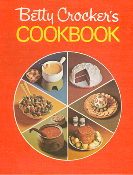 from Betty Crocker's Cookbook (1969)
from Betty Crocker's Cookbook (1969)
Grease popover pans. Beat eggs, then add milk, flour and salt and beat until smooth. Fill cups 1/2 full, or 3/4 full if using muffin pans. Bake at 450° for 25 minutes, then lower oven temperature to 350° and bake for 15 minutes more or until deep golden brown.
The cookbook recommends breaking open and filling with creamed seafood or meat. Jack has mentioned to me that he'd like to make chicken á la king and serve it in popovers.
- 1 cup flour
- 1/2 tsp. salt
- 1 cup milk
- 2 eggs
Beat eggs, then add milk, flour and salt and beat until smooth. Take hot drippings from roast beef and place in square baking pan. Pour batter over the drippings and bake at 425° for 35 minutes.
My mom used to make Yorksire pudding to accompany roast beef. I always preferred it to the beef itself, since my mom favored cheaper, dodgy cuts (like beef heart) that I didn't like.
- 1 cup flour
- 1/2 tsp. salt
- 1 cup milk
- 2 eggs
- 4 TB. vegetable oil
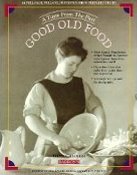 from Good Old Food (1993)
from Good Old Food (1993)
Mix together flour and salt. Whisk the eggs into the milk. Gradually whisk the liquid into the dry ingredients until smooth. Let batter rest for one hour. Heat oven to 450°. Brush muffin cups or popover pan with 1 TB. of the oil. Put the remaining oil into an ovenproof cup and let the muffin cups and the cup of oil heat in the oven for 10 minutes. Whisk the hot oil into the batter, then pour the batter into the muffin cups until each is 2/3 full. Bake for 20 minutes, then lower heat to 325° and bake for 20 more minutes.
First appearance of letting the batter rest before cooking.
The author of the recipe notes that "When I first made them, my family thought I'd become a master baker but popovers will do that for you. They rise so high and look so magnificent that you can't be anything but a superstar when you make them."
- 1 1/2 TB. unsalted butter, plus more for greasing pans
- 1 1/2 cups flour
- 1/4 tsp. salt
- 2 eggs, room temperature
- 1 1/2 cups milk, room temperature
Preheat oven to 425°. Grease popover pans or muffin cups with softened butter (or cooking spray). Place pans in oven to 2 minutes to preheat. Whisk together flour, salt, eggs, milk and melted butter until smooth. Fill popover pans less than half full and bake 30 minutes -- and do not open the oven.
A little more flour and milk than is usual. I've found that with this recipe, moreso than some of these others, it is imperative to let the ingredients come to room temperature.
- 1 cup flour
- 1/2 tsp. salt
- 1/4 tsp. pepper
- 1 cup milk
- 2 eggs, lightly beaten
- 1 can corn, drained
- shortening
- cornmeal
Grease popover cups with shortening, then dust with cornmeal. Place in a 450° oven to heat. Drain the corn, then mix in a food processor with the milk, eggs, salt, pepper and flour. Divide the batter among the prepared popover cups and bake for 20 minutes. Reduce the heat to 325° and bake for 15 minutes more.
I was trying for a corn popover, but it came out more as a corn pudding in a popover shape.
- 1 1/3 cups flour
- 1/2 tsp. salt
- 4 large eggs
- 1 1/3 cups milk
- 5 TB. butter, melted
- 4 tsp. fresh rosemary, minced
Grease popover cups with spray and place in a 350° oven to heat. Mix batter and fill popover cups halfway. Bake for 45 minutes.
Adapted from a Gourmet magazine recipe.
- 2 TB. butter, melted
- 1 cup flour
- 1/2 tsp. salt
- 1 cup milk
- 2 eggs, lightly beaten
- 4 TB. vegetable oil
 adapted from the Williams-Sonoma recipe that came with our popover pans
adapted from the Williams-Sonoma recipe that came with our popover pans
Spray popover cups with nonstick cooking spray. Pour 1/2 tsp. of the melted butter into each cup. Preheat oven to 450° and let popover pan get hot. In a bowl, whisk together the eggs and milk, then the remaining butter. Then whisk in the flour and salt, until smooth, about 2 minutes. Divide the batter among the prepared popover cups and bake for 20 minutes. Reduce the heat to 325° and bake for 15 minutes more.
For the poppyseed popovers in the photo, I added 1 TB. poppyseeds to the batter. I tried "dusting" the greased cups with poppyseeds, but once the pans heated up, the poppyseeds just fell to the bottom.
To make a richer popover, add another 1 TB. butter, and be sure to use whole milk, not skim milk.
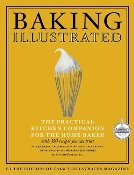 from Baking Illustrated (2004)
from Baking Illustrated (2004)
The popover recipe given in Baking Illustrated is the basic one, but what is more interesting are the thoughts of the author on proper procedures. Some excerpts:
"Popovers are impressive because their few humble ingredients -- eggs, milk, flour, salt and butter -- are transformed by the heat of the oven into the culinary equivalent of hot air balloons. The goal in developing the batter is to create a framework that, like a balloon, can expand and stretch without breaking as pressure is applied from within."
"[We had been leaving our popover batter] a little lumpy so as not to overdevelop the gluten. One or two recipes had different advice: Whisk the ingredients until smooth. We tried this, and the popovers rose a bit higher and their texture began to improve, becoming slightly more airy."
"We decided to let the batter rest on the countertop so that the chilled ingredients could get closer to room temperature before baking. This common baker's pactice gives the batter a bit of a headstart when it enters the oven. This test, too, was a success. Our popovers were growing slowly but surely over the rim of the popover tin, and their interior texture was becoming feathered with eggy layers of dough."
"We tried starting the popovers in a cold oven, and we tried baking them at a constant 375°, as recommended in a couple of recipes. The popovers did rise under these conditions, but not as dramatically as when we started at 450°."
"We also tried preheating the greased pan. The problem was that the butter we had been using to grease the pan burned before the pan had a chance to heat up fully. ... We tried greasing the pan with simple vegetable oil, and the results were every bit as good."
"Popovers are about as simple as a recipe can be: butter, flour, salt, eggs, milk. The magic is all in the chemistry ..."
"Perfect popovers are the result of a hot oven and wet batter: The heat sets the bottoms and sides of the popovers quickly, and the liquid trapped inside creates steam that causes the batter to rise, resulting in a crisp golden puff with a giant air pocket in the middle. It's a perfect not-too-filling bread option for the big feast."

